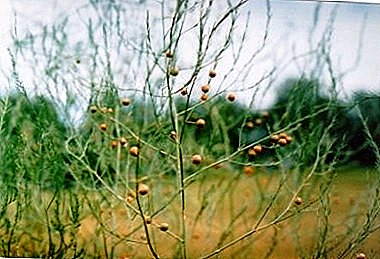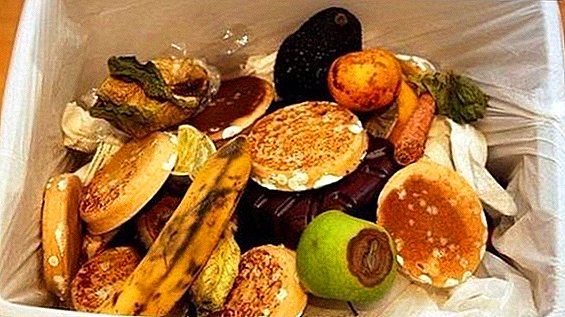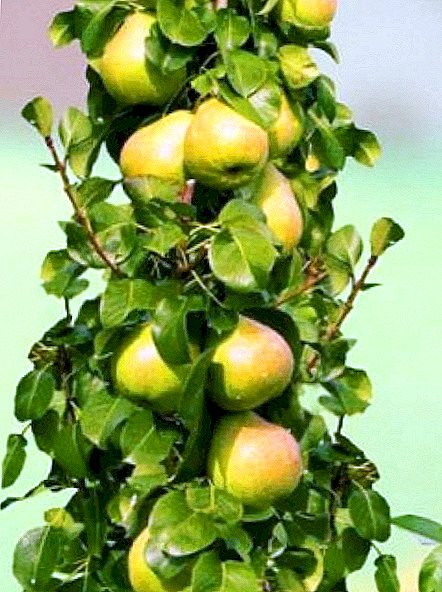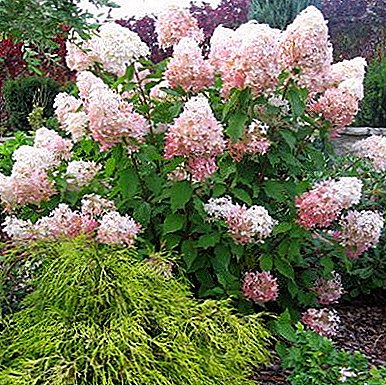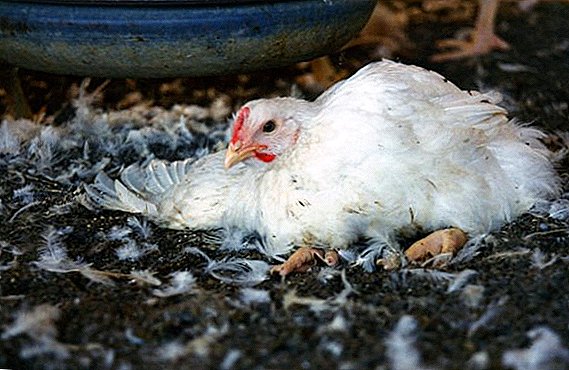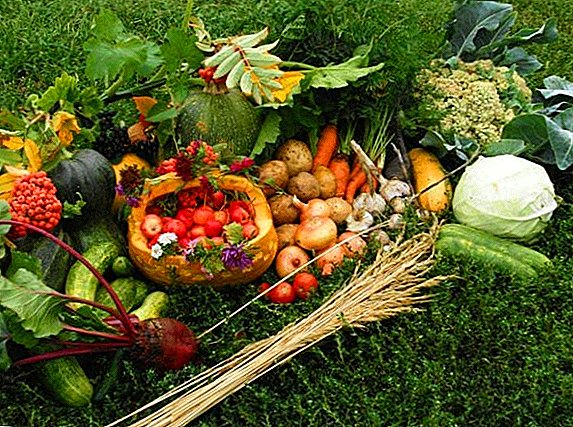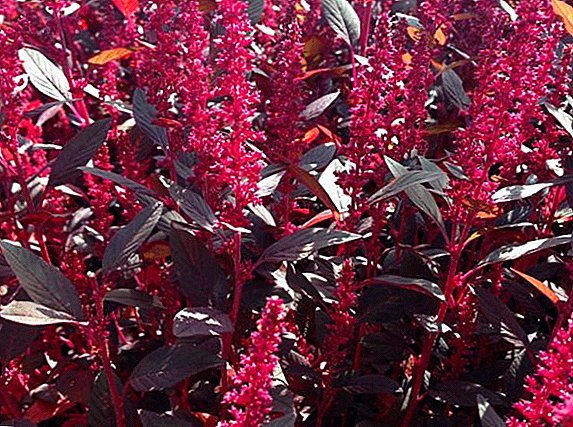 Amaranth (in a simple way "schiritsa") - a plant in our culture is new, although it is known for its healing properties since the times of the King of Peas. Amaranth attracted the attention of biologists and nutritionists as an "ideal" product.
Amaranth (in a simple way "schiritsa") - a plant in our culture is new, although it is known for its healing properties since the times of the King of Peas. Amaranth attracted the attention of biologists and nutritionists as an "ideal" product.
The miracle plant was used as one of the "subsidiary" for sacrifices. The Indians considered him "unfading" and so frightened the Spanish conquistadors with them that they decided to destroy the plant, hoping to save the Indians themselves from the custom of sacrifice.
Most of us know about the healing properties of amaranth. But how to use them, we will tell in the article.
The chemical composition of amaranth
Amaranth - protein-rich plant and quite high in calories - 371 kcal / 200 g That is why amaranth oil is one of the most popular and saturated with various beneficial substances:
- Vitamin PP - 0.66 mg.
- Vitamin B9 - 85 micrograms.
- Vitamin B6 - 0.19 mg.
- Vitamin B5 - 0.06 mg
- Vitamin B1 - 0.03 mg
- Vitamin B2 - 0.16 mg
- Vitamin A - 146 mcg
- Vitamin C - 43.3 mg
- Vitamin K - 1140 mcg
- Selenium - 0.9 mcg
- Iron - 2.32 mg
- Copper -0.16 mg
- Zinc - 0.9 mg
- Manganese - 0.89 mg
- Magnesium - 55 mg
- Iron - 2.32 mg
- Phosphorus - 50 mg
- Potassium - 611 mg
- Sodium - 20 mg
- Phosphorus - 50 mg

Did you know? Amaranth surpasses wheat and other cereals in many characteristics, because it is in this plant that contains the greatest amount of fatty acids.
Amaranth is popular due to the fact that it consists of only natural and natural substances. It is used in all spheres of human life - from food to expensive cosmetics.
Useful properties of amaranth. How does the plant on the human body
Schiritsa perfectly fights with almost any disease due to the high content of vitamins and minerals.
Useful properties of amaranth seeds
 Shchiritsy seeds - real pantry of protein and vegetable fats. From the seeds make flour, which can be used for the preparation of any bakery products.
Shchiritsy seeds - real pantry of protein and vegetable fats. From the seeds make flour, which can be used for the preparation of any bakery products.
Seeds of varieties such as "kizlyarets"and"ultra". They are not only the largest, but also contain a large amount of squalene - a substance that nourishes the body with air and is a powerful immunoprotector.
Amaranth seeds are appreciated due to the fact that they do not contain gluten in their composition, which is very important for people leading a healthy lifestyle. Amaranth is used to treat various diseases, as well as in cosmetology and animal husbandry.
What is useful amaranth foliage for a person?
Amaranth leaves contain a large amount of lysine and carotene, and the level of protein in it is completely off scale. Amaranth leaf is similar to spinach in its composition, but surpasses it.
Very often in Japan, the nutritional value of amaranth leaves is compared to squid meat. Scientists mention that amaranth can be used as a means to improve immunity, because the leaves contain a large amount of vitamin C and carotene. They remove toxins and toxins from the body.
 It is better to use young leaves before the plant blooms, because the old foliage is tougher and contains less nutrients. Amaranth leaves can be used both raw and cooked, they are added to the preservation, which helps to keep the vegetables in the jar crispy.
It is better to use young leaves before the plant blooms, because the old foliage is tougher and contains less nutrients. Amaranth leaves can be used both raw and cooked, they are added to the preservation, which helps to keep the vegetables in the jar crispy.
Important! The daily rate of amaranth should not exceed 150 g, because the foliage contains a large amount of oxalic acid.
Use of amaranth
In cooking
In cooking, amaranth has been used since the time of the Aztecs - these sensible people began to cook porridge from amaranth seeds, and all sorts of salads from foliage. Now there is a large number of variations of these "primitive" recipes.
In cooking, seeds are used as flour for making various klyar and breading. Very popular amaranth leaf sauces or simply stewed leaveskilled in mousses or mashed potatoes.
The leaves are used for brewing tea, stewed fruit, and often added to juices. Amaranth is used even for chops! Recipe very simple - only we take vegetables instead of meat. Roasted amaranth seeds, mashed potatoes and peas, carrots and two eggs. Cutlets cut as usual and fry on both sides.
 Amaranth is very praised by those who used it for cooking "useful energy"- very ripe tomatoes grated through a sieve should be mixed with bread kvass, add a little amaranth leaves and a spoon of black ground pepper - a cheerfulness charge is provided for the whole day.
Amaranth is very praised by those who used it for cooking "useful energy"- very ripe tomatoes grated through a sieve should be mixed with bread kvass, add a little amaranth leaves and a spoon of black ground pepper - a cheerfulness charge is provided for the whole day.
In cosmetology
Beneficial features amaranth oil Not only cooks, physicians and traditional healers, but also cosmetologists have already noticed for a long time. Amaranth oil contains a large amount of squalene, which not only prevents the appearance of cancer cells, but also maintains an optimal level of skin hydration, slows down the aging process and enriches the skin with oxygen.
Did you know?In amaranth seed oil, vitamin E is found in the active form, and in almost all other vegetable oils, in the passive form.
Amaranth oil to some extent disinfects the skin and has an antibacterial effect. In the use of oil schiritsy very simple: they can wipe the skin ( in particular, for herpes, various minor injuries and 1 degree burns).
Also amaranth oil can be made a “key figure” for a home-made cream by mixing it with glycerin and other aroma oils, or prepare a mask, for example, with oatmeal and butter: oatmeal has a peeling effect, and the oil will moisturize the skin.
 You can also add it to the ready-made cosmetics. For example, first apply the oil, and then on top - cosmetics.
You can also add it to the ready-made cosmetics. For example, first apply the oil, and then on top - cosmetics.
So, amaranth oil is suitable for almost any woman with any skin type, but it should be used wisely.
In animal husbandry
Amaranth is successfully used as a feed crop in animal husbandry. This type of food - the perfect balance in the ratio of protein and carbohydrate components. The productivity of amaranth is much higher than that of the traditional fodder crop - maize. On 1 ha comes out about half a ton.
Green mass used for making haylage and silage. Amaranth is popular not only because of the high protein content, but also because of the huge amount of carotene, riboflavin, folic acid, betaine, lysine and B vitamins, which increase appetite and, as a result, accelerate the growth of animals.
In medicine
 Amaranth due to its rich composition it reduces cholesterol and blood sugar levels and removes toxins from the body. The use of amaranth speeds up the metabolism and improves immunity. Useful for the cardiovascular system and various diseases of the genitourinary system.
Amaranth due to its rich composition it reduces cholesterol and blood sugar levels and removes toxins from the body. The use of amaranth speeds up the metabolism and improves immunity. Useful for the cardiovascular system and various diseases of the genitourinary system.
The use of amaranth in traditional medicine: the best recipes
How to prepare magic potions from this plant and for what they can be used, let's talk further.
Cold treatment
Amaranth oil for colds can be used in cooked food, which will help moisturize the throat, and in the form of a rinse, dropping a few drops in warm water.
Good for colds will help amaranth leaves added to tea - it will strengthen the body in general and saturate it with vitamin C.
Very useful amaranth fresh juice, which is made from young leaves and gargle in the ratio of 1: 5.
Treatment of the genitourinary system
When treating the urogenital system, amaranth is one of the key components. It is used mostly externally for the healing of small wounds. Amaranth can be used for cervical erosion, inflammation of the ovaries and appendages, myoma, colpitis and many other diseases.
Important! The use of amaranth normalizes hormones in women, if you take one teaspoon per day for 5-7 days.
 Amaranth is effective in the fight against male diseases: vitamin E contained in this plant helps in the fight against infertility, improves or restores erectile function. Amaranth will be a very good helper in the fight against inflammatory diseases of the prostate gland, as well as inflammation of the prostate in men.
Amaranth is effective in the fight against male diseases: vitamin E contained in this plant helps in the fight against infertility, improves or restores erectile function. Amaranth will be a very good helper in the fight against inflammatory diseases of the prostate gland, as well as inflammation of the prostate in men.
Cancer treatment
Amaranth contains a large amount of antioxidants that fight carcinogens, which are the primary cause of the formation of cancer cells in the body. Amaranth not only fights cancer cells, but also helps the body recover from chemotherapy, strengthening the general condition of the body.
To combat cancer cells, you can use the extract of amaranth foliage (200 g leaves 1.5 liters of water) or eat amaranth as salads, porridge, sauces or side dishes.
Treatment of diseases of the kidneys and liver
Amaranth removes all toxins and toxins from the body, and some even argue that regular food intake, of which this plant will be a component, will lead to getting rid of kidney stones.
 Important in the treatment of liver diseases is the fact that amaranth is a building substance for our cells, because it is rich in squalene, which nourishes the body's cells with oxygen and helps them recover faster.
Important in the treatment of liver diseases is the fact that amaranth is a building substance for our cells, because it is rich in squalene, which nourishes the body's cells with oxygen and helps them recover faster.
Regular consumption of any kind of amaranth in food will be a good “ally” in the fight against kidney and liver diseases.
Use of amaranth oil
Amaranth oil can be useful for various dermatological diseases (they can wipe eczema, acne and various redness):
- in diseases of the cardiovascular system (normalizes blood pressure, reduces the risk of thrombosis and dilates blood vessels);
- with anemia (amaranth proteins accelerate the synthesis of proteins in the body);
- with ophthalmic diseases (carotene and vitamin E help improve vision);
- diseases of the nervous system (amaranth optimizes the quality of transmission of nerve impulses to the cerebral cortex).
There is practically no sphere where amaranth would not be useful, and given the pleasant smell of this oil and the finest nutty taste, it is impossible not to love it.
Amaranth storage and storage
The leaves and stems of this plant are harvested before flowering, so that they do not become rigid. They are dried by hanging them to something horizontal in a well-ventilated room, and then they are packaged in bundles.
Seeds need to collect later than the stem part, but you need to have time to collect them before they get enough sleep. Dried amaranth is already clean and cut into pieces.
Did you know? If you dry the amaranth in the fridge on a cutting board, the color of the leaves will be perfectly preserved.
Amaranth dried stored in sealed bags, and the seeds can be stored in a kitchen jar. The main thing in a dark and not very warm place, so as not to damp. By the way, amaranth seeds can be dried in the oven at a temperature of 150 degrees for eight minutes.
Amaranth is also stored frozen in dense packages, but it is not recommended to keep the plant in this form for longer than six months. And if you want pickles from amaranth, then there is also nothing complicated: the plants are cut, blanched and laid out on the bottom of the jar, the top is poured marinade:
- 1 liter of water
- 1/4 liter of 9% vinegar
- 40 grams of salt
- 50 grams of sugar
The leaves retain their juiciness and useful properties.
Contraindications to the use
It would seem that such an ideal plant as amaranth is rich only in healing properties and has no contraindications. But the use of foliage / stem and amaranth oil has its own contraindications.
Important! Despite the fact that the child's body absorbs the plant quite well, it is necessary to introduce amaranth into the daily diet very carefully and consistently, starting with small doses.
Amaranth should not be consumed with severe diseases of the stomach and intestines, with urolithiasis, as well as if you have an individual rejection of this plant. If you have cholecystitis or pancreatitis, it is better to consult with a specialist.
Health is important, and if amaranth is needed for its preservation, then why not!


